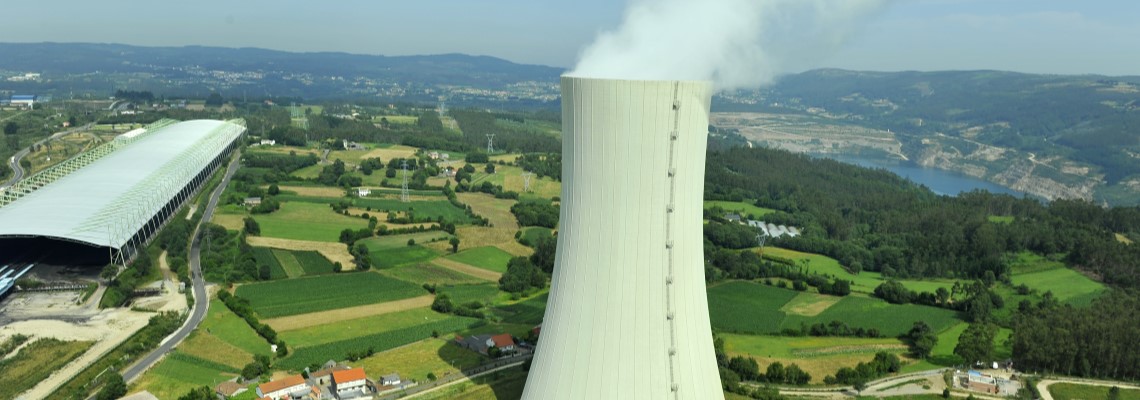Meirama thermal power plant is located in the parish of Encrobas in the province of A Coruña.
Meirama thermal power plant was built in the vicinity of a lignite site to take advantage of this fuel, but depletion of the mine’s reserves meant that in 2008 the lignite was replaced by coal. Naturgy has since transformed the former mine into an artificial lake, Lake Meirama, one of Spain’s largest environmental rehabilitation actions. The project, a 60 million euro investment, consisted of recovering the space affected by mining activity in a sustainable way, creating a large lake in the former mining pit that is 2.2km long and 1km wide (totalling 171 hectares), and reforesting the land and the mine’s tailings heaps. It has created a large, protected biodiverse space that will boost the economic, tourist and environmental development of the area due to its natural value.
Key figures
Year commercial operations began
2 reservoirs, 1 slag and ash landfill
Date dismantling started
Estimated end date for dismantling
Progress of the dismantling
- Availability of electricity transmission point
- Availability of electricity supply
- Industrial land on the entire plot
- Good road communication
- Good rail communication, with own unloading facility
- Close to the gas network: Reganosa gas pipeline on the same plot. Enagás gas pipeline just a few kilometres away
- Close to A Coruña airport (25 km)
- Close to other important industrial installations (Sogama, Repsol, etc.)
- Plot divided into two parts by a road and with areas of different levels
In defining the dismantling works, environmental measures and safety procedures have been considered a priority to ensure they are carried out correctly and that third parties and the environment are not affected.
The buildings and installations at the power plants feature different types and combinations of structural elements. Therefore, a combination of manual and mechanical procedures have been incorporated into the dismantling and demolition methodology, in some cases combining the two types of procedures and using explosives to carry out controlled blasting.
What does the process consist of?
- Cleaning the equipment and installations
- Vaciado y limpieza de tanques y líneas
- Emptying and cleaning the tanks and lines
- Manual work to empty and dismantle the fixtures, sorting them by type
- We carry out specific actions to reduce greenhouse gas emissions and offset our carbon footprint.
- Removing the thermal insulation
- Removing hazardous materials
- Combined demolition:
Demolition using machinery:
By pushing or pulling or using backhoes fitted with cutters to demolish the structure starting from the top and going down.
- Using hydraulic hammers mounted on mobile equipment.
- By controlled blasting to collapse structures and buildings using explosives.
- Sorting demolished materials by type, seeking maximum revaluation and recycling.
- Transferring waste to the different collection areas within the plant.
- Subsequent management according to the type of materials: inert, non-hazardous and hazardous.
- Refurbishing the plot with finishing consistent with an industrial site.
- Removal of protrusions and footings above the current level.
- Filling in holes with suitable material.
- Levelling the area.
- All power installation equipment and the electrostatic precipitators have been scrapped.
- Equipment (stacker, collectors and belts) have been scrapped and the coal shed roof demolished.
- The cooling tower and chimney have been successfully demolished. Filling had previously been removed from the cooling tower and the internal refractory flue from the chimney.
- Demolition of the turbine unit building, belts and coal hopper units is ongoing.
- The boiler and the lift tower have been demolished.
There are around 90 people on site working on these tasks, of which the following are locally hired:
9 people from the Just Transition Institute list (7 of them residents in Cerceda, Ordes or Carral).
17 people from Cerceda, Ordes and Carral.
45 people from other municipalities in the province.
Occasional participation of local companies
Alternative projects
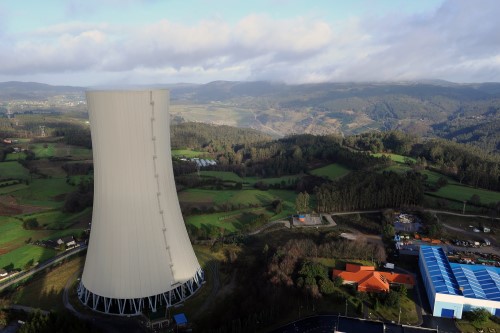
Two wind power generation projects, totalling 64,5 MW, which are expected to generate 467 direct jobs and 373 indirect jobs. For the exploitation phase, 14 direct jobs and 10 indirect jobs are estimated:
- Meirama (44,5 MW)
- As Encrobas (20 MW)
Development of a hydrogen production hub with a 30 MW electrolyser in phase 1,50 MW in phase 2, and up to 200 MW in phase 3, on the land where the thermal power plant is located to supply local industries for consumption as the replacement raw material for grey hydrogen, for thermal uses to replace fossil fuels, for use as fuel in mobility and to inject into the natural gas network. Projected employment for phase 1 of this project is 224 direct and 372 indirect jobs during the construction phase and 14 direct and 24 indirect jobs for the operation and maintenance phase. The project was declared a Priority Business Initiative (PBI) in December 2022 and received a grant of 15 million euros for the first 30 MW phase from the Institute for Diversification and Energy Saving (IDAE) Value Chain call as part of PERTE ERHA programme.
Biomethane project that contemplates the development of an anaerobic digestion plant that would treat livestock waste as well as others such as Organic Fraction of Urban Solid Waste. This process would generate two products: on one hand, biogas that would be taken to an upgrading plant to obtain biomethane and for subsequent injection into a network; and on the other, a fertiliser (liquid and solid) would be obtained from the digested output. Part of the latter could be returned to farmers for use and the rest could be marketed. A total of around 630 tonnes of waste could be managed, producing up to 247 GWh/year of biomethane and thus avoiding over 150,000 tonne/year of CO2 emissions. This project would create 164 indefinite jobs and 160 additional temporary positions for the plant construction and commissioning process.
Project under study
The following project to be carried out by third parties are also under study:
An agreement has been signed for the transfer to a third party of the plant’s non-hazardous waste landfill. The purpose of this landfill was to deposit ash and slag from the plant, and only around 10% of its total capacity is currently used. With transmission to a third party (subject to administrative authorisations) rather than its sealing and closure, there would be capacity for non-hazardous waste storage (in Galicia there is currently little capacity available, and it is foreseeable that new landfills will need to be created in the short term) and this activity would continue in the area, which could involve around ten new jobs.
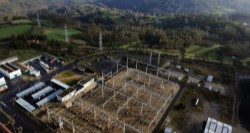
Naturgy ha obtenido la Declaración de Impacto Ambiental (DIA) favorable para el parque eólico Encrobas, paso previo al otorgamiento de la resolución de autorización administrativa y de construcción que permitirán, junto con la obtención de las licencias de obra municipales, comenzar los trabajos de construcción de esta instalación.
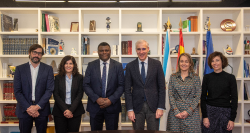
Meirama will house the future Galician renewable hydrogen production hub. The project entails installing an electrolysis plant powered with 100% renewable energy on land once occupied by the Meirama thermal power plant in the town of Cerceda (A Coruña).
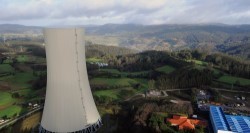
The Meirama wind farm, located in the municipalities of Cerceda, Carral and Ordes, is one of the projects associated with the closure of the Meirama thermal power plant included in the alternative plan that Naturgy is developing, and which will involve new investments in renewable generation and the production of renewable gases in the region and in Galicia in the coming years.

- Global environmental policy
